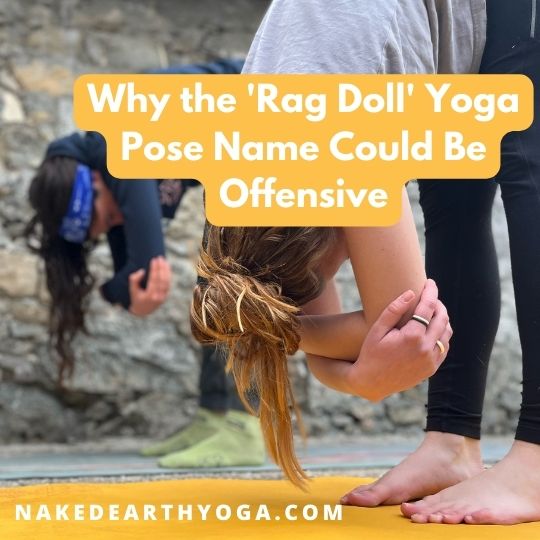Ragdoll pose is popular in many yoga classes. But is the name offensive?
Recently, on Instagram I posted an image of two yogis in what is frequently referred to as “ragdoll” pose in yoga classes. However, I’m going to make the case that this yoga pose name is offensive. It might even trigger some yoga students.
Stay here and see why you might want to rethink the name ragdoll pose in your yoga class.
Affiliate Links Disclosure: Naked Earth Yoga is reader-supported. When you buy through links on our site, we may earn an affiliate commission at no added cost to you. Thank you for reading. You can read the full privacy policy here.
What is ‘Ragdoll’ Pose?
In yoga practices, ‘ragdoll’ is a the name for a popular tension releasing pose. In short, it looks like you are folded over facing your knees, with your legs hip width apart and slightly bent.
From that posture, your hands grab the opposite elbows. In the posture, yoga teachers often instruct students to release the tension in their neck and shoulders, and to let go, sometimes swaying gently.
How to Get into Ragdoll Pose
One way to get into ragdoll pose is to approach the posture from downward facing dog. You walk your feet toward your hands (near the top of the mat). Of course, there are variations. Some yoga teachers bring their students into rag doll after a forward fold.
The Benefits of ‘Ragdoll’ Pose
Rag doll is a tension release posture. It can help yoga students let go of neck, shoulder, and back tension. Additionally, it can help loosen up the lower back. It can even relieve pain or improve stress levels.
The Problem with Ragdoll Pose
Though the posture itself is welcomed by many yoga teachers and yoga students, the name of the posture is problematic.
Honestly, I cringe whenever I heard this ‘rag doll’ yoga posture.
Let me tell you why.
Trigger Warning: This Post May Make you Feel Uncomfortable
Beyond the yoga context, in North American culture (maybe in others too, but I have no idea and I haven’t taken the time to research it), the name is literally tossed around.
Specifically, it’s tossed around as a sexually and intellectually degrading depiction of women.
Not convinced? Google the phrase or hop over to urban dictionary to see for yourself.
Yes, we are living in more educated and aware times. Significantly, our words matter.
They especially matter when you’re teaching a yoga class. As yoga teachers, using our words mindfully and practicing non-harming comes with our turf.
Ahimsa: Our Words Matter
Of course, we can’t always anticipate or predict the impact of everything we say, but consider this:
What if you knew this commonly used name for this posture might trigger a yoga student? What if you knew a student had been subjected to violence and heard this name used to describe her/him?
Would you still use it?
I’m not suggesting as a yoga teacher that you have to tip toe around your words. I’m not even suggesting that you have to ditch this name.
However, I think there’s a lot of value in getting curious with ourselves, with others, with our language and words. There’s value in getting curious with our reactions, with our undertanding (or lack of).
Futhermore, there’s value in getting curious about our way of doing things, even (and maybe especially) when we’ve always done something one way. Or, in this case, when we’ve simply aways said something because that’s just the way it has been said–or we’ve been taught.
READ MORE: To learn about other problematic or cringey yoga words, check out Cringey Yoga Words and Why Some Yoga Teachers Don’t Say Namaste.

Comments: I’d love to hear your thoughts. And as always, thank you for showing up in this little space on the Internet.

